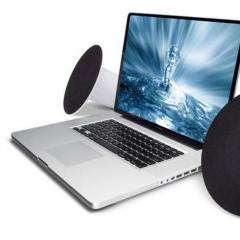Optimal Nvidia graphics card settings for gaming. NVIDIA Driver Control Panel Guide 3D Settings Incompatible with Integrated Graphics
Part 4. General overview of the game's graphic settings
Overall, a good article on the graphical settings of this game (with screenshots comparing different settings) on the NVidia website: www.geforce.com/whats-new/guides/tom-clancys-the..
(but nevertheless, the material there is based on the “trust but verify” principle)
What I personally will say in the end:
- Image - Brightness: I always set this setting for myself to 100% - it’s better when it’s light in multiplayer than if it’s dark (yes, this particular option sometimes disappears after restarting the game, and you need to pick it up again)
- Graphics - Graphics quality:
- Graphics - Vertical Sync:
- Graphics - Frame limit: In the course of our story, this setting has remained “off” for now. - turning it on is only relevant for modern top videos
- Graphics - Shadow quality: In the course of our story, this setting has so far remained at the “low” value. The PCSS and HFTS values make super-cool shadows with clear contours and other effects (this in itself is for shadows for multiplayer, there is some doubt), while eating up a lot of productivity - and in the end, can only be relevant for cool videos, provided that this particular video card generally supports this particular technology
- Graphics - Shadow resolution: In the course of our story, this setting (going “hand in hand” with the previous setting) has so far remained at the “low” value. Increasing this setting greatly reduces productivity, and is only relevant for cool people
- Graphics - Number of local shadows: the setup is described above in the story
- Graphics - Local shadow resolution: the setup is described above in the story
- Graphics - Contact shadows: In the course of our story, this setting has remained “off” for now. Increasing this setting leads to an increase in the quality of contact shadows, which in that very article on the NVidia official website are characterized as “mouse fuss, not noticeable in multiplayer.” So I leave it with me, set to “off.”
- Graphics - Post-effect anti-aliasing:
- Graphics - Temporal Anti-Aliasing:(anti-aliasing) setting is described above in the story
- Graphics - Scalable resolution: In the course of our story, this setting has so far remained at the value “100%”. This is DSR - turning it on may be important for cool video games with 8+ gigs of video memory on board (you need to turn it on starting from NVidia Control Panel - Manage 3D settings - Global Settings - DSR Factors) - to get cooler anti-aliasing than all this baby talk with "regular" anti-aliasing (FXAA, MFAA, TAA, etc.)
- Graphics - Image sharpness: the setup is described above in the story
- Graphics - Particle quality: In the course of our story, this setting has so far remained at the “low” value. So I leave it with me - in multiplayer we don’t need all sorts of sparks and fragments to block the view of the enemy.
- Graphics - Effect of wind on falling snow: In the course of our story, this setting has so far remained set to “no”. This setting only affects the effect of wind-blown snow flowing around the corners of buildings - and the wind in the game always affects falling snow, even when this setting is disabled (see that NVidia offsite article); but in multiplayer we don’t need falling snow to distract us by falling “not by default” - that’s why I leave this setting set to “no”.
- Graphics - Volumetric fog: In the course of our story, this setting has so far remained at the “average” value. When you increase this setting, it improves the picture quality very little (it makes the fog illuminated by light sources just a little better) - but it eats up a lot of performance - I recommend turning it on only for owners of top-end video games
- Graphics - Reflection quality: In the course of our story, this setting has so far remained at the “low” value. So I leave it with me - because... all these reflections in puddles, in shop windows, etc. - are more likely to interfere in multiplayer (than if all these reflections are “cloudy” and hardly noticeable)
- Graphics - Quality of local reflections: In the course of our story, this setting has remained “off” for now. I’ll say the same thing about it as about the previous setting.
- Graphics - Internal Scattering: the setting is described above in the story (makes the reflection of light from various surfaces, including from the skin of faces, snow, etc. “soft”, which significantly improves the pleasantness of the game picture)
- Graphics - Anisotropic filtering: the setting is described above in the story
- Graphics - Parallax Maps: in the course of our story, this setting has remained “off” for now. This setting, when increased, gives the illusion of relief to surfaces that do not have (or have few) their own original details - for example, a brick wall, itself flat, becomes with a feeling of relief of the bricks on them. I don’t know exactly whether this setting affects the rendering of characters, but it’s not worth “enriching” all possible walls and other “background” surfaces in multiplayer with reliefs (complicating the visibility of characters for the sake of the visibility of these walls) is not worth it, so I leave this setting at “ off".
- Graphics - Background Shading: in the course of our story, this setting has so far remained at the “low” value. I recommend further increasing this setting only for cool videos - because... further “increase in quality” will be barely noticeable, but a fair amount of productivity will be consumed
- Graphics - Depth of field: In the course of our story, this setting has remained “off” for now. We don’t need to “blur” the part of the picture that is not in the character’s focus of vision - also, from experience, when this setting is turned on, sometimes it works “at the wrong time” in the game - it blurs the background at a time when it shouldn’t be blurred - and can “let you down” in gameplay.
- Graphics - Object detailing: the setup is described above in the story
- Graphics - Increased broadcast range: the setup is described above in the story
- Graphics - Chromatic aberration: In the course of our story, this setting has so far remained set to “no.”. This setting, when enabled, makes the game picture look like an “old film” - the same effect also makes the game picture more “blurry”. In that article on the NVidia website, doubts were expressed about this setting, which is very amateurish and also “blurs” the game image at the same time. In multiplayer, it is definitely better for the picture to be clear (not this). Therefore, I leave this setting at “no.”.
- Graphics - Neutral lighting: In the course of our story, this setting has so far remained set to “no.”. This setting, when enabled, makes the game picture more “dark horror”. We don’t need the picture to become darker in multiplayer - that’s why I leave this setting at “no.”.
- Graphics - Lens flare: In the course of our story, this setting has so far remained set to “no.”. In multiplayer, we don’t need to be distracted by these additional glares (and block our view in it) - that’s why I leave this setting set to “no.”.
- Graphics - Vignetting: In the course of our story, this setting has so far remained set to “no.”. We don’t need this darkening of the game image at its edges when playing in multiplayer - so I leave this setting at “no.”.
Hello admin, here's a question. How to enable the built-in video card if there is a powerful discrete one in the system unit (installed separately). I just want to check, just in case, whether the built-in one works or not. In short, I’ll tell you my whole story.
I bought a new system unit; the ASUS motherboard has a built-in video card, but I have never connected a monitor to it, since I also have a powerful discrete NVIDIA GeForce video card, which I use constantly. And at a certain moment, the image on the monitor began to appear in stripes and began to periodically disappear, I decided to check whether the video card built into my motherboard was working. With the computer turned off, I disconnect the DVI cable from the discrete video card and connect it to the built-in one, then I turn on the computer and there is nothing on the monitor, just a black screen, and the system unit is working at this time. As a result of this, I came to the conclusion that not only is the discrete video card defective, but the one built into the motherboard also does not work. Am I right or wrong?
How to enable the built-in video card
You are half right, your discrete video card may be faulty, but if you wanted to use the built-in video card, then first of all you need to enable it in the BIOS. Or another way - you just need to remove your separately installed video card from the connector (of course, with the computer turned off) and then the built-in video card will automatically connect to work. More complete information should be in the instructions for your motherboard.You can learn how to remove a video card from the system unit from our article -. That's how enable built-in video card I'll tell you in BIOS now.
We reboot the computer and enter the BIOS; for those who don’t know, read this article. Almost all modern computers have a UEFI BIOS, click Advanced.

Enter advanced mode. OK. You can select the System language Russian.

And everything in your UEFI BIOS will be in Russian, but few people work like that, learn to work in the English interface. First I will show you how to do everything in Russian, and then in English.
Advanced tab. System agent configuration.

Graphics options.

Set the Main display option to iGPU - integrated graphics.

To save the changes we made to the BIOS, press the F10 key,

then Yes and reboot.

Turn off your computer, connect a DVI or VGA cable between your built-in video card and monitor, then turn on your computer. And install drivers on the connected built-in video card.
Go to Device Manager, right-click on the built-in video adapter and select Update Drivers from the menu.


Automatic search for updated drivers. If the driver does not install automatically, it means .
If the interface language of your UEFI BIOS is English.
Advanced Tab, System Agent Configuratio n,

Then Graphics Configuration.

We set the Primary Display option to the iGPU parameter - integrated graphics,

save the changes - press the F10 key, then Yes, reboot.

Turn off the computer, connect your built-in video card and monitor with a DVI or VGA cable, turn on the computer, install the drivers.
Increasingly, questions arise about disabling the built-in video card in the computer and enabling the external video card. There are many reasons for Intel HD Graphics to turn off. The most common example is a problem in older computer games that can clip heavily.
Well... we didn't buy the best equipment just to refuse additional support. In this article, we will show you an easy way to disable the integrated Intel HD Graphics card.
We will explain step by step using the example of the most popular video card model installed on computers and laptops, NVIDIA GeForce.
Along with installing the GeForce video card driver, we receive software for managing the card settings - “NVIDIA Control Panel”. The applet is accessible from the control panel.
First we need to get to the control panel. A universal method that works on Windows XP, Vista, Windows 7 and Windows 8 is to call the Run window. For Windows XP, Vista, Windows 7 and Windows 8, the easiest way to call it is by pressing a key combination WIN+R, then enter control or control.exe.

In the control panel (small icons) select the NVIDIA control panel. If you look in category mode, NVIDIA can be found in the “Design and Personalization” section.

You can also use the NVIDIA settings icon, which is located in the system tray or in the context menu - “Change default GPU”.
To disable the integrated Intel HD Graphics graphics card, go to the “Manage 3D Settings” tab.

By default, the preferred GPU is automatically selected. We change the automatic selection to an NVIDIA processor with high performance and confirm the changes by clicking the “Apply” button.
We can also change the preferred video card selectively, in relation to a specific program (game). For this purpose, we use another tab - “Program Settings”. We indicate the application or game, after which we select the desired video card from the drop-down list.
An even simpler solution to disabling Intel HD Graphics is to use the context menu. When you right-click (briefly) on a game or application file, select from the menu “Run with GPU” - “NVIDIA High Performance Processor”.
In the case of ATI (Radeon) cards, the procedure is similar. Everything can be configured through the Catalyst Control Center control panel, in the PowerPlay (Switchable Graphics) power management section.
In some cases, you may need to disable the integrated graphics card using your computer's BIOS. This function of disabling the integrated graphics card can have different names, for example, Primary Graphics Adapter (PCI, PCI Express and OnBoard/Internal) or Onboard GPU with the Enable If No Ext PEG and Always Enable options.
If you have any doubts, be sure to read the instructions included with your computer/laptop, or ask on the forums and/or in the comments to the article.
The methods presented above do not completely disable the integrated graphics card. Complete disabling is only possible through the BIOS. However, the safest solution is to set the graphics card selection from the operating system. Then support for games and applications is carried out through the processor of an external video card.
By default, all software for Nvidia video cards comes with settings that imply maximum picture quality and the overlay of all effects supported by this GPU. These parameter values give us a realistic and beautiful image, but at the same time reduce overall performance. For games where reaction and speed are not important, such settings are quite suitable, but for online battles in dynamic scenes, a high frame rate is more important than beautiful landscapes.
In this article, we will try to configure the Nvidia video card in such a way as to squeeze out the maximum FPS, while losing a little in quality.
There are two ways to configure the Nvidia video driver: manually or automatically. Manual tuning involves fine-tuning the parameters, while automatic tuning eliminates the need to tinker with the driver and saves time.
Method 1: Manual setup
To manually configure the video card parameters, we will use the software that is installed along with the driver. The software is simply called: "Nvidia Control Panel". You can access the panel from the desktop by right-clicking on it and selecting the desired item in the context menu.

- First of all, we find the point "Adjusting Picture Settings with Preview".

Here we switch to settings "According to 3D application" and press the button "Apply". With this action we enable the ability to control quality and performance directly by the program that is using the video card at a given time.

- Now you can move on to global parameter settings. To do this, go to the section "Manage 3D Settings".

On the tab "Global Settings" we see a long list of settings. Let's talk about them in more detail.


- After completing all settings, click on the button "Apply". Now these global parameters can be transferred to any program (game). To do this, go to the tab "Program settings" and select the desired application in the drop-down list (1).
If the game is missing, then click on the button "Add" and look for the corresponding executable file on disk, for example, "worldoftanks.exe". The toy will be added to the list and for it we set all the settings to "Use global setting". Don't forget to click on the button "Apply".

According to observations, this approach can improve performance in some games by up to 30%.
Method 2: Automatic setup
Automatic configuration of an Nvidia video card for games can be done in proprietary software, also supplied with the latest drivers. It's called software. This method is only available if you are using licensed games. The function does not work for pirates and repacks.

By performing these steps in Nvidia GeForce Experience, we tell the video driver the most optimized settings suitable for a specific game.
These were two ways to configure Nvidia graphics card settings for gaming. Advice: try to use licensed games to save yourself from having to manually configure the video driver, as there is a possibility of making a mistake and not getting exactly the result that was required.



